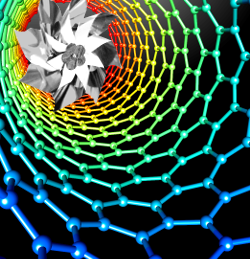Spinning nano-crystals find their own forms
 Simply making certain nanoparticles spin causes them to leap into life, of a sort.
Simply making certain nanoparticles spin causes them to leap into life, of a sort.
Researchers in the US have hit upon what they call ‘living rotating crystals’; spinning microscopic particles which sort themselves into some pretty astounding arrangements, and possibly into entirely new states.
The finding may also shed some light on the spark that turns chemicals into life itself.
The living crystals appear to adhere to a simple set of rules that springs from their spinning behaviour.
A team of chemical engineers at the University of Michigan have found that when individual nanoparticles are spun around in a simulation – the particles self-assemble into an intricate architecture.
The complex arrangement was found in broader investigations of ways to get nanoparticles to assemble themselves – and important technique when trying to build structures from pieces thousands of times smaller than a grain of sand.
Investigating natural methods for creating balance and order can reveal something about the very first steps that living organisms took out of the primordial soup, according to researcher Dr Sharon Glotzer.
“If we can understand that, not only can we begin to imagine new ways to make materials and devices, but also we may begin to understand how the first living structures emerged from a soup of chemicals,” said Glotzer, who is also a professor of materials science and engineering, macromolecular science and engineering, physics, and applied physics.
“One way biology approaches the challenge of assembly is by constantly feeding building blocks with energy. So, that's what we did with nanoparticles.”
Seperate findings have recently revealed that when particles are given a push for a basic motion - such as moving in a single direction - they can begin to influence one another, forming groups.
Dr Glotzer's team looked at what would happen if the particles all were made to rotate.
“They organize themselves,” said Daphne Klotsa, a research fellow in Glotzer's lab.
“They developed collective dynamics that we couldn't have foreseen.”
The team's computer simulation can be imagined as two sets of pinwheels on an air hockey table. The air pushing up from the table drives some of the pinwheels clockwise, and others counter-clockwise.
When the pinwheels are tightly packed together, their blades catch on one another and they begin to divide themselves into clockwise and counter-clockwise spinners—a self-organizing behaviour known among researchers as ‘phase separation’.
The separation occurs because of the way the blades collide. While a pair of pinwheels may be spinning in the same direction, at the point their blades might meet they are actually moving in opposite directions. This means that the blades will push into one another and stick together, causing the pair of pinwheels to briefly rotate as one.
In contrast, the blades of opposite spinners are moving in the same direction where they meet, so they do not stick together. Since the same-spinning pinwheels spend more time linked up, they gradually accumulate into groups.
When the pinwheels divide into clockwise and counterclockwise tribes, the boundary between the groups becomes a thoroughfare for particles in the mix that aren't spinning.
The simulations were conducted in two dimensions, as though on a flat surface, but the team anticipates that rotating particles could also grow into ‘living’, three-dimensional crystals.
They believe the particles would be free to turn their spin axes in any direction, so they could eventually form a 3D liquid crystal with aligned axes.
The results will be formally presented at an upcoming meeting of the American Physical Society.








 Print
Print